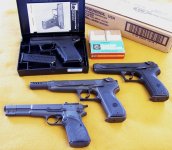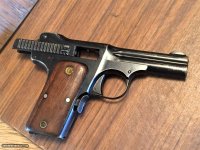JohnHL
Member
The orig TSMG though not a handgun used a bronze block engaging the steel breech bolt at a slight angle. The two dis-similar materials thought to slow down the action speed as they slipped apart.,,at least slower than if the block had been made of steel like the bolt.
The idea was to create a delayed blowback action in the weapon.
Some say it's nonsense science (that principle itself).
Whatever,,the later WW2 versions of the TSMG , the M1 (M1A) were made straight blowback and w/o the complicated system. They seemed to work OK.
Ah yes, the dubious "Blish Device".
I was hoping someone would bring it up.
Thanks!
John







































